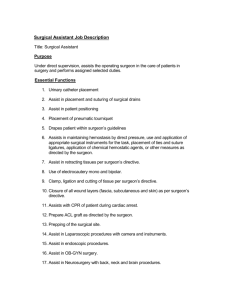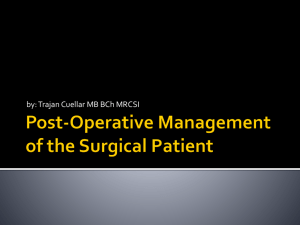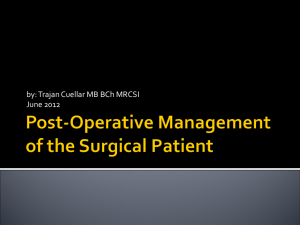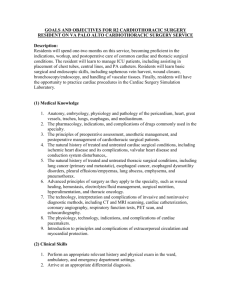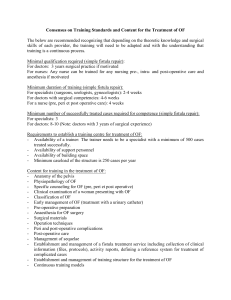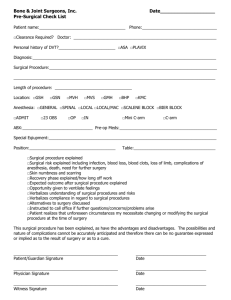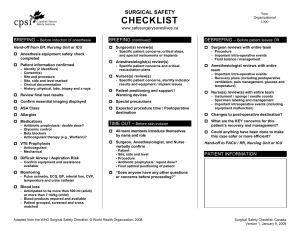approved
advertisement
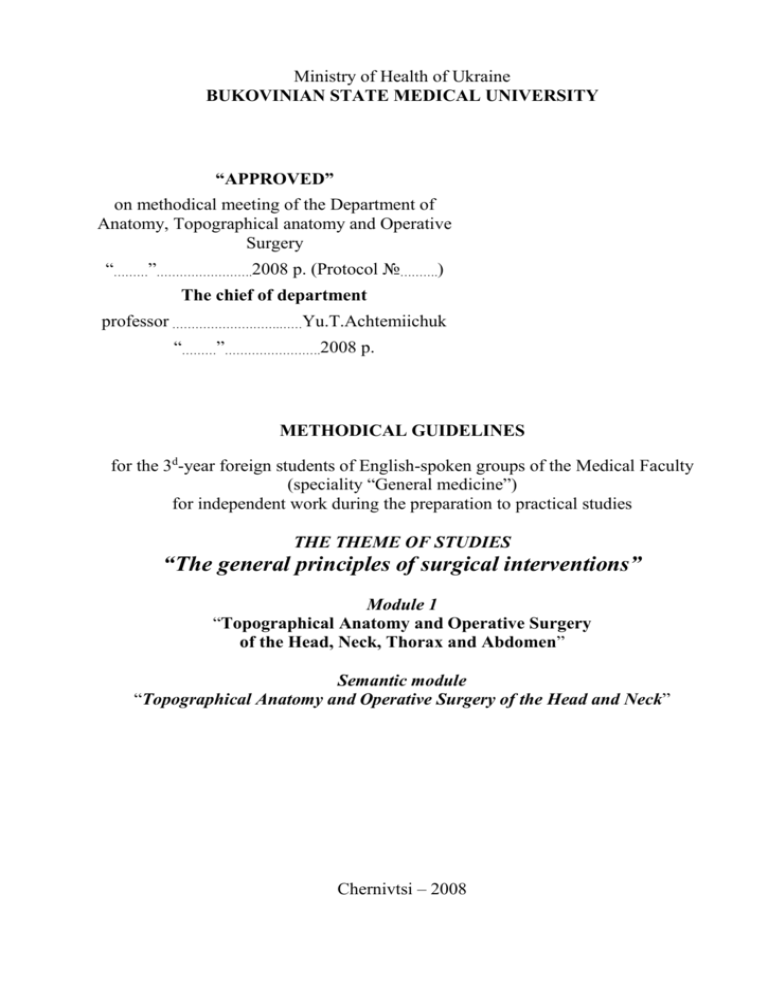
Ministry of Health of Ukraine BUKOVINIAN STATE MEDICAL UNIVERSITY “APPROVED” on methodical meeting of the Department of Anatomy, Topographical anatomy and Operative Surgery “………”…………………….2008 р. (Protocol №……….) The chief of department professor ……………………….……Yu.T.Achtemiichuk “………”…………………….2008 р. METHODICAL GUIDELINES for the 3d-year foreign students of English-spoken groups of the Medical Faculty (speciality “General medicine”) for independent work during the preparation to practical studies THE THEME OF STUDIES “The general principles of surgical interventions” Module 1 “Topographical Anatomy and Operative Surgery of the Head, Neck, Thorax and Abdomen” Semantic module “Topographical Anatomy and Operative Surgery of the Head and Neck” Chernivtsi – 2008 1. Actuality of theme: The topographical anatomy and operative surgery are very importance, because without the knowledge about peculiarities and variants of structure, form, location and mutual location of their anatomical structures, their age-specific it is impossible to diagnose in a proper time and correctly and to prescribe a necessary treatment to the patient. Surgeons usually pay much attention to the topographo-anatomic basis of surgical operations. 2. Duration of studies: 2 working hours. 3. Objectives (concrete purposes): To know the definition of topographical anatomy and operative surgery, surgical operation. To know classification of surgical operations. To know the kinds of surgical operations. To be able to define the main steps of surgical operations and manipulations. 4. Basic knowledges, abilities, skills, that necessary for the study themes (interdisciplinary integration): The names of previous disciplines 1. Normal anatomy 2. Physiology 3. Biophysics The got skills To describe the structure and function of the different organs of the human body, to determine projectors and landmarks of the anatomical structures. To understand the basic physical principles of using medical equipment and instruments. 5. Advices to the student. 5.1. Table of contents of the theme: The operative surgery is the science about surgical operations, methods of surgical operations, the essence of which comes to mechanical action upon the organs and tissues with diagnostic, medical or reconstructive purpose. The operative surgery studies, elaborates and applies operative approaches and techniques taking into account preoperative preparation, operative technologies and properties of postoperative period. A surgical operation is one of the crucial stages of comprehensive checkup treatment of the patient of surgical type. During the operation the surgeon takes into account the anatomical accessibility, technical possibility and physiological propriety of operation – the principles, formulated by the outstanding surgeon M.N.Burdenko. The anatomical accessibility is the securing of fastest access to the object under operation without injuries of vitally important structures. For this aim the surgeon is guided by the projections of interior organs (viscera) and neurovascular fascicles on the body areas, direction of the muscle fibers and fissure-lines of Langer. For example, the left-side access is proved for cervical esophagus, taking into account the declination of this one to the left relative to trachea and negligible possibility of left turning laryngeal nerve injury. The technical possibility is the presence of technical resources, equipment and medical facilities at the disposal of the surgeon for effective and successful realization of complex and laborious stages of surgical operation, opportune ablation of possible complications and total control of the patient’ state. For example, the complex operations on the heart and great vessels need the use of the artificial blood circulation system, systems of vessels machine suture, ultrasound and laser techniques, monitors etc. A physiological propriety is the possibility to save the organ at the most after operation. For example, the operation on pancreas is accessible anatomically and technically is not complicated but it must be the operation exclusively sparing for tissues of pancreas for saving its functionality. The surgical operation is the certain algorithm of mechanical actions of surgeon upon organs and tissues of live person for medical (healing), diagnostic or reconstructive purpose. The surgical operation consists of three main stages: 1)operative approach; 2)operative method; 3)exit of operation. The name of operations is being determined by the operative method and being formed according such scheme as: name of organ + type of action + mode (modification). For example, on account of stomach ulcer are using: the gastrectomy (in other words excision of the part of stomach providing the formation of anastomosis with duodenum stump (method Billroth-1) or with loop of empty one (method Billroth-2). Both methods may be applied according to one of numerous modes (modifications) differing by the technique of anastomosis’ formation. The operation may be named by the author, like the operation of TroyanovTrendelenburg: the operative ligation of great hypodermic saphenous vein near the place of its joint with femoral vein, realized in case of superficial vein varicose of lower extremities. Let us examine the component parts of surgical operation: 1. Operative access – formation of incisional wound within aseptic conditions. Its dimension (direction, length, depth) must ensure the extraction of organ from the wound and placing of surgical instruments at certain angle of operative action for full visual control by surgeon and assistants. The operative access must be comfortable for realizing of operative mode and at the same time mustn’t entail cosmetic effect after operation. According to direction of skin dissections the access can be: slit, oblique, transverse, combined. 2. Operative method – realizing of certain (medical, diagnostic, mechanical) action on body part, or gan or tissues. The name of operation reflects the action: · incisio – the cut (dissection); · amputatio – extraction of peripheral part a limb (e.g. amputation of thigh in middle third); · exarticulatio – extraction of peripheral part of the extremity on the joint level (p.e. exarticula-tion of elbow); · tomia – cut, or dissection (p.e. laparotomy – incision through the anterior abdominal wall); · gastrotomia – stomach cut; · craniotomia – trepanation of the skull; · stomia – fistula, to provide with an opening, or mouth (the surgical creation of an artificial opening into hollow organ; e.g. tracheostomy – an opening into the trachea through the neck; cholecystotomia – form of biliary fistula); · anastomos – formation of anastomosis (fistula) between the hollow organs (p.e. End-to-end Intestinal Anastomosis); · ectomia – ablation (excision) of organ (e.g. cholecystectomy – excision of gallbladder; appendectomy – removing of vermiform appendix of the cecum); · sectio – cutting, dissection of hollow organ (e.g. sectio alta – high dissecton – the dissection of urinary bladder; venesectio – cutting of veins); · resectio – extraction of organ’s part under condition of conservation of peripheral part (e.g. resectio ulcus ventriculi – resection of stomach on account of ulcer; gastric resection – removing of some part of the stomach); · punctio – puncture, perforation, tapping; e.g. punctio pleure – puncture of pleura, punctio fornicis posterioris – puncture of posterior vaginal arch; · rraphia – suture; e.g. gastrorraphic – stomach suture, neurorraphia – nerve suture; · ligature – ligation of vessel; · injectio – injection; · coagulation – cauterization; · im(trans)plantation – a surgical procedure that place in something in the human body; · plasty – the shaping or the surgical formation (gastroplasty – plastic operation of the stomach); · reconstructive operation – is to reassemble or to reform from constituent parts. 3. Exit of operation – is the recovery of normal tissues’ structure layer-by-layer (anatomical and physi ological continuity of structures), violated during the operation. The Classification of Operations According to the term the operations may be: - emergency – operation of the first aid in cases when the delay is dangerous for the patient’s live, for example in case of the arterial hemorrhage is necessary to secure hemostasis, in case of asphyxia – the tracheotomy; - urgent – operation done during first hours after hospitalization. During this period the surgeon keeps the patient under observation and clinical course in dynamics, prescribes necessary diagnostic checkup, expert’s consultation. Example: appendectomy; - planned – operation done at any time but after the systematic examination, reasonable preparation and favorable conditions for patient, for example in case of gastrectomy. The operations may be bloodless (closed surgery) and bloody. Among the bloodless operations are such instrument operations as: cystoscopy, broncho-scopy gastroscopy, colonoscopy; and non-instrument operations: reduction of hip dislocation, shoulder, lower jaw. The bloody operations are entailed by forced injury of vessels during the access. According to character and aim the operations may be radical and palliative. Radical operations are directed to definitive recovery of patient by the elimination both disorder provoked by disease and pathologic nidus (etiopathogenetic substratum of disease). For example, on account of tumor narrowing the intestine open, the radical operation consists in ablation of this tumor with the intestine part (resection), and then the continuity of intestine is revived with the help of anastomosis. The palliative operations are directed to agony relief by means of pathological disorders elimination but the causes of disease remain. So, in the presence of the same tumor narrowing the intestine open for the elimination of obstruction one can make bypass fistula (anastomosis) between adductor and adducent intestine stumps. The inoperable tumor remains. There are single-stage and stages operations. The single-stage operation from beginning to end is realized at one go, that is to say during one surgical operation. The stages operations are realized in cases when the state of patient’s health or the danger of complications doesn’t permit to finish surgical operation at one stage as a result one part of operation is realized one day and other is realized after the patient’s recovery of trauma. For example, in case of supercystic adenomectomy. The excision of prostate adenoma in serious cases divided on two stages. During first stage is carried out epicystostomy (sectio alta of urinary bladder and formation of fistula), then the patient prepares for the next stage of operation – excision of prostate (adenom-ectomia). The stages operations are in common practice widely in plastic surgery when the recovery, or renew, of anatomical structures is realized in several stages, for example, by means of skin item dislocation on Filatov-Gillies tubed pedicle flap to hide the defect. If the surgical operation are realized several times on account of the same disease, it is named reope-ration (repeated operation), for example, the reampu-tation (adding the prefix “re” to the name). There are also operations of choice. This is the group of operations suggested for surgery or certain disease. Amongst them the surgeon or conference of doctors choose that having more advantages (indications) taking into account the clinical diagnosis of patient, his peculiarities and technical possibility of realization. For example on account of stenosing duodenal ulcer under one condition it is possible to carry out the stomach resection by Billroth-2 and under other conditions is possible the organ-preserving operation (selective proximal vagotomy with duodeno-jejunostomy). Diagnostic operations are directed to specification of diagnosis, for example, biopsy, puncture of pleura and joints, laparoscopy, vasography, diagnostic laparotomy and thoracotomy. According to the level of cleanness the operations are divided to four groups: 1. Clean – planned operations without opening of caval organs (herniotomy, spleenectomy, operations on account of heart disease); 2. Relatively clean – operations with opening of cavitary organ (stomach resection, cholecystectomy on account of gall-stone disease); 3. Polluted – operations with inevitable getting of organ’s content into wound (epicystostomy, gastro-tomy, enterotomy); 4. Dirty, or primary-infected – operations on account of peritonitis, abscess, phlegmon, purulent fistula. The operations of pediatric surgery have its peculiarities. They must take into consideration the anatomical and physiological properties of growing organism the mechanism of its posterior development. The emergency operations can be carried out successfully after birth (surgical correction of congenital malformation). There are certain terms of realization in expedient time for the diseases which need urgent operation. On of main task of pediatric surgeon is the right choice about the term of operation. The child’s age cannot be the contraindication to surgery. The development of pediatric surgery and anesthesiology, in-depth study and understanding of pathologic processes produce constant reconsideration of the operation terms as a rule towards earlier ones. The Deeds of the Surgeon during typical Operation I. Operative approach means to make the wound for exposure the organ to be operated on. 1. Preparation of the operative field: hands of the surgeon to ensure asepsis during surgery, using surgical clothes and linen to cover the area to be cut. 2. To mark the skin for dissection, to use local anesthesia if necessary. 3. The incision of the soft tissues (e.g. laparo-tomy), making the wound, control of hemostasis. 4. The revision (exploration, abdominoscopy, surgical revision) of the abdominal cavity, delivering organ into the wound. Methods of revision – inspection and palpation. II. Operative method – the main part of the operation, performing the action contained in the name of the operation. 1. To determine the border between healthy pathologically changed tissues of the organ (limits of resection). 2. Mobilization of the organ – cutting from the sources of blood supply, mesenteries (ligaments). 3.Application of clamps to avoid flouring out (spillage) the content of the organ into the body cavity. Crushing forceps are applied on the part of the organ to be removed, the elastic ones – on the remaining part. 4.Proper operative method (p.e. cutting off). 5.Renewal, or reconstruction, of the anatomical and physiological integrity and continuity of the orga-nocomplex (anastomosis, peritonization, placing sutures etc.). III. Exit of operation. 1. Obtaining a careful hemostasis. 2. Insertion a drain through the wound. 3. Suture of the wound. 4. Aseptic bandage. STAGES OF SURGICAL OPERATION 1. The Surgeon and Patient Preparation to the Operation A surgical operation is realized in sterile conditions. A prevention of penetration of infection to the operative wound is named asepsis and fight against an infection in a wound is named antisepsis. The basic principles of asepsis and antisepsis were formulated by Semmetweiss, Paster and Lister. In 1867 Lister for the first time reported about the use of carbolic acid as an antiseptic remedy. In 1882 Trendelenburg, Bergman, Shimmelbush and Furberger came to the conclusion about steam sterilization. The aseptic trend in surgery became the priority after American Khalstedt (student of Lister) had applied sterile rubber gloves in 1890, and the English Hunter had used sterile facial mask in 1900. The sterility (an absence of bacteria and their spores) on the preparative stage of surgeon and patient to the operation is provided by certain measures in preoperative and operating rooms: - the surgeon changes his clothes to surgical suit and scrubs his hands; - putting on of operating dressing-gown; - preparation of the operating field. The putting on of surgical suit and scrubbing of hands. In a preoperative room a surgeon changes his clothes to surgical suit (shirt, trousers, cap, mask, shoe covers) and scrubs his hands according to one of possible methods. The preparation of surgeon hands for the operation provides: - mechanical cleaning of skin: cleaning of dirt and microorganisms from the skin surface by warm water and brush; - elimination of microbes on a skin by solution (chemical treatment); - compression of skin (tanning) is with the aim to close opens of road clearances of sweat and oil glands. The mechanical cleaning of hands’ skin is carried out by washing of hands with sterile brush and soap. A brush is moved in direction from fingers to the forearm. The hands all of time turn up higher then forearms to let flow warm water run from fingers to the elbow. Firstly the palm’s surface of every finger of left hand is washed, back surface of every finger, intervals between fingers and nail beds of left hand. Then the right hand is washed by the same order. After that begins washing of back and palm’s surface of left hand, and then right hand and, finally, wrists and forearms to the level of the their upper third is washed. The lather is constantly washed off by running water; a brush is soaped if necessary. During washing of hands and after it is prohibited to touch anything. In the case of error the washing of hands starts from the beginning. Elimination of Skin Microbes by Antiseptic Solution The method of Alfred. The hands are wiped by 96% ethyl alcohol during 5 minutes. Nail phalanxes and back interphalangeal folds are cleansed by 5% solution of iodine. The method of Furbringer. The hands are wiped during 1 minute by solution of mercuric chloride in correlation 1:1000, and then are wiped by a 96% alcohol during 3 minutes. After this the nail beds are smeared by 5% iodine solution. The method of Spasokukotsky-Kochergin. The hands are cleaned by 0,5% liquid ammonia solution. The hands are washed in two basins for 3 minutes by a napkin; consistently doing motions, as at washing a brush, beginning from the fingers of left arm. In the first basin the hands are washed to the elbows, and in the second they are washed to the border of upper and middle third of forearm. At the end of washing hands are rinsed by the solution of liquid ammonia and lift the hands up to let the water drops flow down from elbows. From this time the hands are constantly higher then forearms. The skin of hands is drained by sterile napkins: firstly both hands (this napkin is thrown down), then consistently lower and middle thirds of forearms. The skin is disinfected by napkins, moistened of 96% alcohol, cleansing twice the hands and lower third of forearms. Then the finger-tips, nail walls, nail beds and finger skin folds are smeared of 5% alcoholic iodine solution. The hands’ treatment by “pervomur” (C-4 preparation). “Pervomur” is a mixture of formic acid and hydrogen peroxide. Firstly the basic solution area prepared in such correlation as 80 ml of 85% formic acid and 170 ml of a 33% hydrogen peroxide solution mixed up in glass-ware with ground stopper and matured in the refrigerator during 2 hours. When interacting formic acid hydrogen peroxide the superformic acid appears as a result having strong bactericidal activity. From 250 ml of basic solution it is possible to make 10 litres of work solution “pervomur” soluton, mixing it up with the distilled water. The work solution is suitable to apply only one day. After washing by running water with soap during 1 minute, hands and forearms are washed with napkins in a basin with “pervomur” solution during 1 minute up to the level of their the middle third and are dried with sterile napkins. In one basin 5 persons can wash their hands. The hands’ treatment by chlorhexidine bigluconate. Issued as 20% water solution. For hands’ treatment are prepared 0,5 % alcoholic solution: to 500 ml of 70% alcohol is added the 12,5 ml of 20% solution of chlorhexidine bigluconate. After washing by running water with soap the hands are dried by sterile towel, and then are wiped with gauze tampon moistened by prepared solution, during 2-3 minutes. The speeded-up method of hands’ treatment. This method is applied in ambulatory and military field conditions. For the speed-up hands’ treatment is used the disinfecting membrane-forming preparation Cerigelum having strong bactericidal effect. It consists of butyral resin and of 96% ethyl spirit. The hands are washed with water and soap, and are dried carefully. The palms are filled with 3-4 ml of Cerigelum, the fingers, nail beds and nail walls, brushes and lower part of forearms are moistened carefully, during 10 seconds. The half-bent fingers are maintained separated during 2-3 minutes, up to the Cerigelum film appears on a skin. This film has protective and bactericidal characteristics, and after operation it is easily taken off by gauze swabs moistened by alcohol. The rapid hands treatment can be done by the special apparatus with ultrasonic baths, in which washing and disinfecting of hands takes 1 minute. For that the hands are dipped into the bath with antiseptic solution of, through which the ultrasonic waves let pass providing the “washing effect”. In urgent cases hands’ skin treatment is carried out by such modes as: - The method of Khaysner. The skin of hands is cleansed without previous washing with water with soap but only with 5% solution of iodine in petrol. - The method of Bruna. The hands are washed by 96% alcohol during 10 minutes. An obligatory condition of this method of skin treatment is that hands must be dry. - The method of Zabludovsky. The hands are washed by 5% solution of tannin in an alcohol (80-96%) during 2-5 minutes without previous water washing. The general lack of these methods of hand preparation is that a skin loses the elasticity. This reduces to traumatism and to development of pustular diseases. In addition, all described methods of hands treatment do not provide complete and protracted sterility. That is why after hands’ skin treatment a surgeon puts on sterile rubber gloves after antiseptic solution treatment. 2. Putting a sterile Surgical Coat on Putting on of sterile surgical coat is the important measure of prophylaxis of contact infection. From the surgeon is required observance of accuracy, because sterility of his clothes and hands can be violated at this moment. A surgeon take a sterile surgical coat from sterilizer box (there surgical coat are convoluted in a tube internal surface outside) and, having unwrapped it on his hands extended forward, returns it interior to itself. It is necessary to watch after the external surface of sterile surgical coat does not touch surrounding objects and operating suit of surgeon. With the help of that is to say diving movements the surgeon throws the surgical coat over itself at the front keeping hands up. The nurse of operational unit pulls up a surgical coat by the edges and ties it. A surgeon takes from the pocket of surgical coat a belt and, holding it in the distance 30-40 cm from itself, asks a nurse carefully to hold free ends and tie them behind. A surgeon ties the glands by himself or with the help of scrub nurse. The unwrapped surgical coat can be given to surgeon by a scrub nurse. She holds a surgical coat in front of herself, external surface toward herself, throwing surgical coat arms on the hands. A surgeon comes and put his hands into the sleeves of surgical coat. An operating sister puts a surgical coat on the surgeon shoulders, and a nurse helps him tie up himself. Pulling up sleeves, the glands are tied by surgeon or scrub nurse. 3. Preparation of the Operative Field Preparation of the operative field to the operation consists of solution treatment of skin and covering (isolations) sterile surgical garb (by sheets, towels, napkins). The operative field is an area on the body surface, which can contact with sterile surgical instruments and gloves of surgeon. Area of the operative field is determined not only by operative wound size, and also by confines of body cavity projection which contains an organ – operative object. For example, before implementation of laparotomy of border of skin treatment are mentioned below: upper border – the level of nipples, lower border – upper third of thighs, lateral – reach lumbar area. The prevention of infecting of operating wounds by microbes located on patient’s body, carried out hygienical skin treatment before operation and special skin treatment in the area of operation on operating table. The hygienical patient’s skin treatment is carried out in a reception centre, or in a surgical department immediately before planned operation. A patient takes a bath. A hygienical skin treatment must be done after implementation of all of preparatory procedures: cleansing enema, gastric lavage, catheterization of urinary bladder. After hygienical skin treatment the patient puts on a clean linen and he is transported into operating-room. Immediately before is necessary to shave off hair in the area of future operating cut. After shaving off of hairs a skin is not treated. If the patient’s state is grave and he needs immediate surgical operation, the hygienical treatment of skin can be done in an operating-room by the antiseptic solution. Sometimes in such cases one can limit himself only to treatment of the operative field. The skin treatment methods of the operative field do not differ from the methods of hands treatment of surgeon in principle. It is forbidden to utilize alcoholic solution of iodine for treatment of the operative field. Instead a 1% solution of iodonatum (iodopironum) is utilized. The method of Filonchikov-Grossikh. Filonchikov (1904), and after him Grossikh (1908) introduced skin treatments of the operating field the procedure of tanning, which provides closing of efferent ducts of sebaceous and sudoriferous glands, the tanning prevents the microbe appearing on skin surface. The offered method consists of the four-time skin smearing by 10% alcoholic solution of iodine: - first smearing – 5-10 minutes before of cut of skin; - second smearing – immediately after the cut of skin; - third smearing – before sutures on a skin; - fourth smearing – after sutures on a skin. For the mechanical cleaning of skin the petrol is utilized if necessary. The operative field is not washed by water with soap, because a moistened skin has worse reaction to tannins. The Operative Field Treatment by Modern Antiseptics The modern antiseptics are surface-active material, which have high bactericidal action, good moistening and washings properties. They penetrate deep into the skin and provide protracted asepsis: aseptol, diocidum, degmicidum, novoseptum, roccal etc. The operative field treatment is carried out by skin smearing from the place of future cut to periphery and in a presence of infected wound in the center of the operative field – vice versa from periphery to center. The very seat of infection is isolated from the place of cut. During the operative field treatment by novosep-tum (3%) or degmicidum (1%) the skin is wiped a sponge moistened in anticeptic solution during 4-5 min., whereupon it is dried out by sterile napkins. The operative field treatment by 1% roccal solution skin is wiped with a gauze swab moistened in anticeptic solution of, during 2 minutes. The appeared spume is moved off by a sterile napkin. The operative field treatment is carried out of 1% iodonatum according to procedure mentioned below: the skin is smeared twice by sterile tampons moistened in the element (5-7 ml) of antiseptic solution prepared before the operation by solution of preparation by boiled or distilled water in correlation 1:5. The “pervomur” solution for operative field treatment is prepared the same way as for hands treatment. A skin is wiped twice for 30 seconds by napkins moistened in antiseptic solution. After operative field treatment by aseptol the skin is wiped for 3 minutes by a gauze tampon moistened of 2% antiseptic solution. After treatment by antiseptic it is expedient to cover the operative field a sterile sticking polymeric film. A cut can be done through film which remains on skin till end of operation. For children and patients with a sensible skin the operative field is treated by the method of Bakkal: double smearing of 1% solution of brilliant green. The operative field is isolated (covered) sterile linen (sheets and towels) to avoid surgeon hands and instruments contamination and by unsterile parts of patient’s body. In the immediate vicinity from the operative field sterile linen is packed in four layers, in periphery – in two layers. The preparation to the operation ends with fixing of all of sheets and towels by four special sphincters (linen hook) in the corners of appeared “window”, where access will be realized. In the place of future cut the skin is treated once again twice with antiseptic – before of local anaesthesia and after it. During the access the surgeon limits the dissected layers of tissues by towels to avoid their infecting by pathogenic micro-flora which can appear in abdominal cavity. In the process of operation, the protecting of organs and tissues from bacterial contamination from the side of the infected seats is achieved by use of often changeable sterile napkins, towels, repeated of personnel hands treatment. At the end of operation, before and after sutures on a skin, the edges of wound are smeared by anticeptic again. In modern surgery practice the high level of sterility of the operative field is achieved be its complete isolation from air of operating-room inside the closed room. 5.2. Theoretical questions to studies: 1. 2. 3. 4. 5. 6. Put the definishen of the surgical operation. Classification of the surgical operations. The naming of the surgical operations. The main steps of the surgical operation. The principles of parting of tissue. The principles of connecting of tissue. 5.3. Materials for self-control: 1. Give a demonstration of correct using of surgical instruments for the parting of tissue. 2. Give a demonstration of correct using of surgical instruments for the arrest of bleeding. 3. Give a demonstration of correct using of surgical instruments for the suturing of tissue. 4. Give a demonstration of correct using of the accessery surgical instruments. 5. Give a demonstration of knots tying. Literature 1. Snell R.S. Clinical Anatomy for medical students. – Lippincott Williams & Wilkins, 2000. – 898 p. 2. Skandalakis J.E., Skandalakis P.N., Skandalakis L.J. Surgical Anatomy and Technique. – Springer, 1995. – 674 p. 3. Netter F.H. Atlas of human anatomy. – Ciba-Geigy Co., 1994. – 514 p. 4. Ellis H. Clinical Anatomy Arevision and applied anatomy for clinical students. – Blackwell publishing, 2006. – 439 p.


